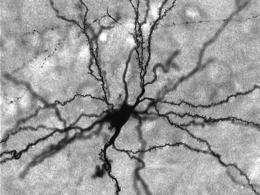Calcium channels optimize learning

(PhysOrg.com) -- Researchers at the Friedrich Miescher Institute for Biomedical Research, Switzerland, have shown how calcium channels in the brain have a positive impact on learning. Their results have been published in the current edition of the renowned scientific journal Nature Neuroscience.
Practice makes perfect. With each repetition, specific connections between individual neurons in the brain are strengthened. This is learning.
In this process, molecular mechanisms are modulated at the junctions between neurons, the synapses, in such a way as to optimize transmission of information from one cell to the next. The interplay always involves one cell transmitting information across the synapse and another receiving it. As in a radio, the transmission and reception must be optimally adjusted on both sides to achieve maximum auditory comfort. Researchers already understand quite well how the "receiver cell" is modulated in the learning process. It becomes more receptive to the signal due to a build-up of receptor molecules in the synapse. However, hitherto it was not known what happens in the "transmitter cell" at the molecular level, and how it regulates the signal strength.
Neurobiologists at the Friedrich Miescher Institute for Biomedical Research, which forms part of the Novartis Research Foundation, have now shown for the first time, in the current edition of the scientific journal "Nature Neuroscience", how the connection between two neurons which emanates from the "transmitter cell" is strengthened by learning.
When the "transmitter cell" is repeatedly activated, as occurs during learning, an increased amount of calcium flows into the neuron via protein channels, known as N and P/Q-type voltage-dependent calcium channels. However, the activity of these calcium channels diminishes again after each learning stimulus, and it was unclear hitherto, how the connection between the two neurons is strengthened long term.
In other words, it was not understood how the information learned becomes "embedded" over the longer term. Andreas Lüthi and his team are the first to show that a different calcium channel, an L-type channel called L-VDCC, is specifically involved in achieving this lasting effect. If this calcium channel is blocked following the learning task, the synaptic connection is weakened again and the information learned quickly forgotten. If the channel is activated without a stimulus, the synapse is strengthened - just as if something really had been learned. L-VDCCs are therefore responsible for the "transmitter cell" transmitting a stronger signal after the learning process, which strengthens the connection between neurons long term.
Andreas Lüthi's research team has focused specifically on learning processes during the onset of anxiety states. "We believe, however, that the same principle could apply to different learning processes in different parts of the brain," stated Lüthi, underlining the importance of these new findings.
More information: Fourcaudot E et al. (2009) L-type voltage-dependent Ca2+ channels mediate expression of presynaptic LTP in amygdala. Nature Neuroscience, 2 August 2009, doi:10.1038/nn.2378
Provided by Friedrich Miescher Institute for Biomedical Research














